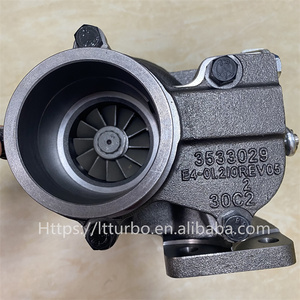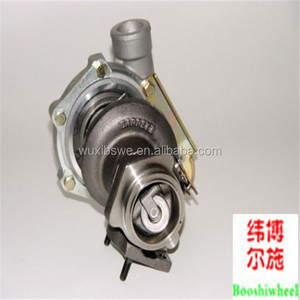(27935 products available)















































































































































































Electric turbochargers have several advantages over conventional turbocharged systems. They improve engine responsiveness, allow for engine downsizing, and work efficiently at low engine speeds. Electric turbochargers are classified into the following categories:
Electric Twin-Scroll Turbocharger
The electric twin-scroll turbocharger is a suitable choice for small and medium-sized internal combustion engines. It is useful in boosting engine performance. The ES Turbo divides the exhaust pulses from the cylinders. It sends the separated exhaust pulses into their respective chambers in the turbine housing. As a result, the twin-scroll turbo gets two inlet channels and three outlet channels. The ES Turbo allows for faster spinning and improves the boost pressure level. It delivers a better response time and increases the overall efficiency of the electric twin-scroll turbocharger.
Electric Variable-Geometry Turbocharger
The electric variable-geometry turbocharger (eVGT) controls the airflow entering the turbocharger and optimizes the boost pressure. The eVGT features adjustable vanes that help to change the direction of the air entering the turbine. By doing so, it ensures that the turbine spins at the desired speed. The eVGT system enhances the low-end torque and provides a consistent boost across the entire engine speed range. As a result, it improves the engine's performance and efficiency.
Electric Supercharger
The electric supercharger adds electrical power to the intake air. It is useful in increasing the intake air volume and density. The electric supercharger features a high-speed fan. When the driver steps on the accelerator pedal, the fan turns on and starts drawing air from the cabin. It forces the air into the intake manifold. The forced air boosts the manifold pressure and increases the engine's power output. The electric supercharger also helps to reduce turbo lag.
Electric Twin Turbocharger
The electric twin turbocharger utilizes two turbochargers to boost engine performance. The first turbocharger forces air at low engine speeds, while the second turbocharger kicks in at higher engine speeds. Both turbos work together to ensure a smooth and linear power delivery. The eTwin Turbo system helps to reduce lag and provides a seamless boost across the entire RPM range.
Regular inspection
The health of the electric turbochargers can be determined through regular inspections. It is recommended that users inspect the electric motors, cooling systems, and other components of the e-turbos regularly. If there is damage, it should be repaired quickly. They should also check for any signs of wear, damage, or carbon buildup. The intake and exhaust ports should be inspected for any obstructions or deposits that may hinder airflow.
Using high-quality oil
High-quality oil should be used for electric turbochargers. The oil should meet the manufacturer's specifications. It plays the role of a lubricant and ensures that the e-turbos run smoothly. Users should replace the oil at the intervals suggested by the manufacturer. This will prevent the oil from breaking down and causing damage to the turbocharger.
Cool-down periods
When driving, the electric turbochargers may become hot due to long periods of high power. Drivers should remember to give the car some time to cool before turning off the ignition. This is because the high heat can cause damage to the e-turbos in the long run.
Air filter maintenance
The air filters of the electric turbochargers should be maintained. The air filters should be cleaned regularly to avoid blockages. Users should also replace them according to the manufacturer's recommendations. Air filters that are in good condition will improve the efficiency of the e-turbos. They will also ensure that clean air flows through the system.
There are several factors to consider when choosing any electric turbocharger, and they are listed below.
Understanding the Engine's Performance Requirements
When selecting an electric turbo, understanding the performance requirements of the engine is crucial. The power output, torque requirements, and the engine's power delivery characteristics should be considered. By understanding these factors, the right electric turbocharger can be chosen to match the engine's performance needs.
Consider the Electric Motor's Specifications
The specifications of the electric motor integrated into the turbocharger should be considered. Look for a motor with a higher power output and efficiency to provide better airflow and boost pressure. The motor's response time is also important; a quicker response time ensures faster spool-up and more immediate boost delivery.
Evaluate the Turbocharger's Design and Features
Different electric turbochargers have varying designs and features that affect their performance. When choosing, consider the turbo's size, turbine and compressor wheel design, and housing construction. Variable geometry and adjustable twin-scroll designs may be included in the electric turbocharger to enhance efficiency and response across a wider operating range. Additionally, consider the compressor and turbine materials, as lightweight and durable materials can improve overall performance.
Compatibility with the Engine
Ensuring the electric turbo is compatible with the engine is essential. Consider the installation requirements, such as available space, mounting options, and exhaust and intake connections. Additionally, ensure that the electric turbo matches the engine's characteristics, such as displacement and tuning, to achieve optimal performance and reliability.
Quality and Reliability
Selecting a reputable and trustworthy manufacturer for the electric turbo is essential. Consider the quality, reliability, and durability of the electric turbo. Research customer reviews and expert opinions to understand the product's performance and longevity. A high-quality and reliable electric turbo can ensure consistent and dependable performance over time.
Installing an electric turbo on a car can be a complex task, but it can be done with the right tools and basic mechanical knowledge. Here's a step-by-step guide on how to install an electric turbo:
1. Choose the Right Electric Turbo Kit: There are many electric turbo kits available in the market, so choose the one that fits the make and model of the car. Ensure that the kit includes all the necessary components, such as the electric motor, fan blades, and housing.
2. Gather the Necessary Tools: To install an electric turbo, car owners will need basic hand tools, such as wrenches, pliers, screwdrivers, and a socket set. They may also need a few specialty tools, such as a torque wrench or an intercooler pipe removal tool, depending on the kit and their car's make and model.
3. Prepare the Car: Before starting the installation, it's important to prepare the car. Disconnect the car's battery and remove any necessary components, such as the air intake duct or intercooler pipes, to access the turbocharging easily. Follow the manufacturer's instructions to determine which parts need to be removed.
4. Install the Electric Motor: The electric motor is the heart of the electric turbo and is responsible for spinning the fan blades. Find a suitable location to install the electric motor, such as near the existing turbo or on the intake manifold. Secure the motor in place using the provided mounting hardware or appropriate methods.
5. Connect the Intake and Exhaust: Attach the intake and exhaust pipes to the electric turbo, ensuring a proper fit and seal to prevent air leaks. Use the provided clamps or appropriate tools to secure the connections. If using an electric variable turbocharger, connect the control system according to the manufacturer's instructions.
6. Reassemble and Test: Once the electric turbo is installed and all connections are secure, reassemble any removed components, such as the air intake duct or intercooler pipes. Reconnect the car's battery and start the engine to test the electric turbo. Ensure everything functions properly and listen for any unusual noises or issues.
Remember, installing an electric turbo can be a complex task, and if unsure or unfamiliar with the process, it's always best to consult a professional mechanic or automotive expert for assistance. Improper installation or handling can lead to engine damage or other issues.
Q1: Are electric turbochargers worth it?
A1: Electric turbochargers are worthwhile because they improve performance and efficiency, especially in lag reduction. They are suitable for various vehicle types, including EVs, hybrids, and traditional combustion cars.
Q2: What are the pros and cons of electric turbos?
A2: The advantages of electric turbos include increased power, better fuel efficiency, and lower emissions. On the flip side, they may have a high initial cost and require regular maintenance.
Q3: How long do electric turbos last?
A3: Electric turbos can last between 100,000 and 200,000 miles, depending on factors such as maintenance, quality, and usage.
Electric turbochargers have maintained a steady average monthly web search volume of 6600 over the past year, showing no significant change in interest over that period. The keyword experienced minor fluctuations on a monthly basis, with peaks reaching as high as 8100 web searches in January 2024 and lows dipping to 5400 web searches in several months including December 2023, April 2024, and May 2024.
This trend indicates a stable interest in electric turbochargers among consumers and industry professionals, without any notable spikes or declines over the past twelve months. The web search volumes demonstrate a pattern of returning to the average after brief excursions upwards or downwards. For instance, following the high in January 2024, the web search volume quickly normalized back to the average of 6600 in February 2024.
The consistent return to the average web search volume suggests a solid, ongoing demand for information about electric turbochargers, which likely correlates with their relevance in the automotive industry, particularly in the development of more efficient and eco-friendly vehicle models. The lack of significant year-over-year or quarter-over-quarter change could imply market maturity or saturation in the interest towards this technology, barring any major technological breakthroughs or regulatory changes that could shift consumer or industry focus.